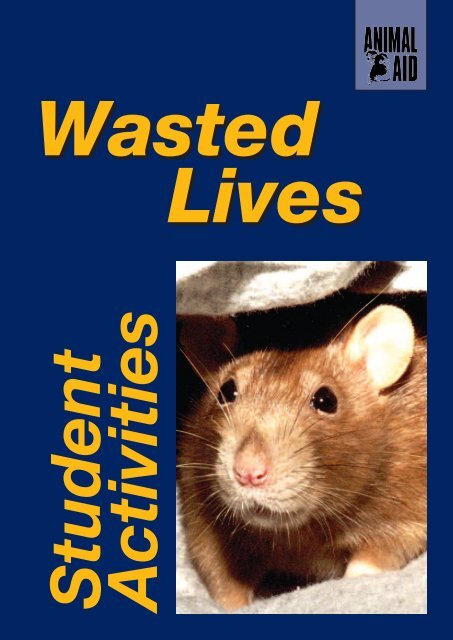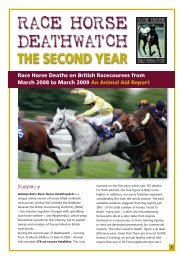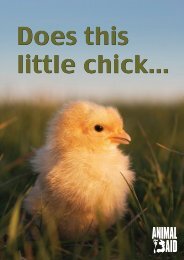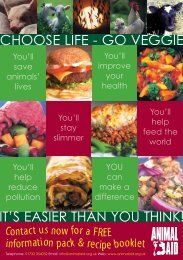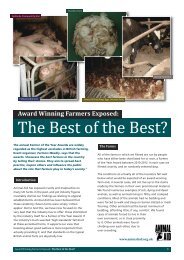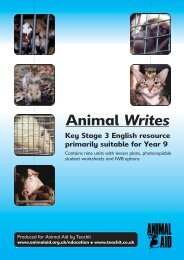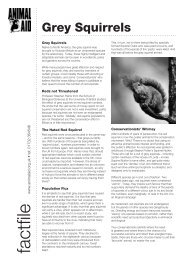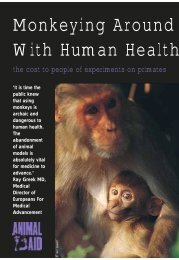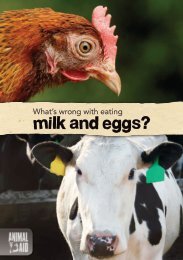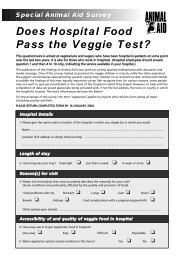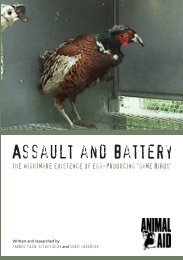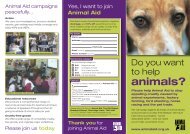Download Wasted Lives Student Activities booklet - Animal Aid
Download Wasted Lives Student Activities booklet - Animal Aid
Download Wasted Lives Student Activities booklet - Animal Aid
Create successful ePaper yourself
Turn your PDF publications into a flip-book with our unique Google optimized e-Paper software.
<strong>Student</strong> <strong>Activities</strong> to accompany the film<strong>Wasted</strong> <strong>Lives</strong><strong>Student</strong> <strong>Activities</strong>IntroductionThe <strong>Wasted</strong> <strong>Lives</strong> film looks at the issue ofvivisection and puts the case against the use ofanimals in scientific experiments. It is suitable foruse with students at KS4 and sixth form.This resource book contains a package ofstructured lessons or workshop activities relevantto a wide range of subjects including citizenship,PSHE, English, RE, social studies, media studies, general studiesand science. (See p29/30 for National Curriculum coverage)Each work unit consists of teachers’ notes and photocopiablestudent worksheets.All work units are balanced. <strong>Student</strong>s are encouraged to investigateand discuss the issues, consider the differing points of view and arriveat their own conclusions.ContentsUnit 1 Video Response 3 - 9Unit 2 What Do You Think? 10 - 12Unit 3 Where Do You Draw the Line? 13 - 16Unit 4 Role-Play 17 - 25Unit 5 Moral Dilemmas 26 - 28Curriculum coverage 29 - 302
Unit 1 Video Response Photocopiable Worksheet 1Before and After5) Before you watch the film, briefly summarise your thoughts about animal experiments.Before . . . .6) Having seen the film, briefly summarise your immediate response. For example, feelings andthoughts, or things that shocked or surprised you. Have you changed your mind at all? Do you feelbetter informed or more confused? Use single words, phrases or complete sentences.After . . . .7) Your group’s task is to produce a list of responses that accurately expresses how your group feltabout the DVD. Listen to each group member’s response to the film. Can you agree or not? Youmay be able to arrive at a consensus, or you may find there is such a wide difference of opinionthat you can’t agree on a joint group response.Feedback session: Someone from the group reports back with your group’s response to the rest ofthe class.6
Unit 1 Video Response Photocopiable Worksheet 1You are a Film CriticDVDs and programmes on TV are produced for various reasons - to entertain, inform, educate,advertise or sell you something, or to persuade. It helps to be able to distinguish between fact andopinion, bias and objectivit1) The film has been produced for a purpose. What do you think was the aim of the DVD?What were the main points made in the film?Aim:Points:2) Would you describe the film as:(Put a tick or cross or give a score out of five for each of the points belowobjectivesubjectivebiasedbalancedboringinterestingqqqqqqpersuasiveunconvincingsensationalist/over-emotionalinformativecovered the issue thoroughlyraised more questions than itansweredqqqqqq3) Imagine your group is taking part in a TV programme reviewing the DVD that you have seen.Your group’s task is to produce a list of responses that accurately expresses how your group feltabout the film. Listen to each group member’s response to the DVD. Can you agree or not? Youmay be able to arrive at a consensus, or you may find there is such a wide difference of opinion thatyou can’t agree on a joint group response.Feedback session: Someone from the group reports back with your group’s response to the rest ofthe class.7
PossibleScoreUnit 1 Video Response - Quiz Photocopiable Worksheet 3QuizAfter watching the DVD, try this quiz - see how many of the questions you can answer.1) How many animals are used in experiments in the UK every year?a) Several hundred qb) Between 10,000 and 40,000 qc) Approximately 500,000 qd) Around 3 million q12) List 4 types of animal experiments.___________________________________ ____ /_____________________________________________________________________________ /______________________________________23) What is Toxicity Testing?______________________________________________________________________________24) List two products that you regularly use, that may have been tested on animals._______________________________________ /______________________________________25) Which animal is used for the Draize test?______________________________________________________________________________16) Name six animal species commonly used in experiments.___________________________ /________________________ /___________________________________________________ /_________________________ /_______________________27) Apart from the pain of the actual experiments, in what other ways do you think animalsin laboratories may suffer?____________________________________________________________________________________________________________________________________________________________6______________________________________________________________________________8
PossibleScoreUnit 1 Video Response - Quiz Photocopiable Worksheet 38) Name one example of an animal reacting differently to a drug or medicine comparedto humans.____________________________________________________________________________19) Name one example of a medical drug that caused harmful side effects in humansdespite being tested first on animals.____________________________________________________________________________110) Name two measures that were largely responsible for more people living longer today.______________________________________ /____________________________________211) List four ways of doing medical research that do not involve the use of animals._______________________________________ /___________________________________________________________________________ /____________________________________12) When and where do you think vivisection started?a) Second Century BC Greece qb) In Middle Ages France qc) Early 1700s England qd) 1920s America q13) Since the introduction of the <strong>Animal</strong>s Scientific Procedures Act 1986 (the law governinganimal experiments in labs), which, if any, of the following statements do you think arecorrect?a) Any worker in a lab who witnesses cruelty to an animal must report it. qb) All experiments causing pain must be conducted with the use of anaesthetic. qc) The nature of all experiments must be published for public inspection. qd) There has never been a successful conviction of a vivisector under the Act. q14) Which of the following animal experiments, if any, do you think are currentlyprohibited?a) Household products testing qb) Biological weapons testing qc) Testing of illegal addictive drugs qd) None of the above q4222Total Score out of 30:9
Unit 2Teachers’ NotesWhat Do You Think?The workshop involves students studying and discussing a series of statements aboutanimal experiments and/or animal rights.It is an ideal follow-up to the DVD and is a stimulus for class discussion. It aims to promotethought and discussion by showing that there is a wide range of opinions relating to thiscontentious issue. It encourages students to think about their own views and perspectives.MethodThere are two student worksheets: one entitled What do you think about animal experiments?and a second animal What do you think about animals? There are various ways of runningthis activity. Here are two suggestions.Hand out copies of the worksheets to individuals or pairs of students. Ask them to readthrough the statements and then:Option 1 Photocopiable worksheets 1 and 2• Ask students to tick those boxes on the right to indicate which statements they agreewith and which they disagree with.Ask them to circle the statement they feel most strongly about (either agree or disagreewith). ...... 10 min• Collect feedback from students and carry out class discussion. 10 min +...... Total time: 20 min +Option 2 Photocopiable worksheets 1 and 2• Cut up the labels on the worksheets and ask pairs or groups of students to arrangethem in order, with those they agree with most at the top and those they disagreewith most at the bottom.10 min• Collect feedback from students and carry out class discussion. 10 min +...... Total time: 20 min +10
Unit 2 Photocopiable Worksheet 1What do you think aboutanimal experiments?AgreeNot sureDisagree1 We don’t have the right to use animals as laboratory tools2 We have the right to experiment on lesser species for our own benefit3 We need to experiment on animals to find cures for diseases such as.... cancer and AIDS4 The results from animal experiments are misleading because animals are.... biologically very different from people5 .<strong>Animal</strong> testing is necessary to ensure that cosmetics and household .... ........ cleaning products are safe for people to use6 It is wrong to use animals in experiments to test non-essential products.... .such as cosmetics and household cleaning products7 .Laboratory animals don’t suffer - there are laws to ensure that they are.... .properly cared for8 It’s wrong to use genetic engineering to create new animals for research9 Experiments on farm animals are justified because they enable farmers to.... .create more productive livestock10 .It’s all right to test on rats and mice, but not on cats, dogs or monkeys11 <strong>Animal</strong> laboratories need to keep what they do secret to protect the ........ .scientists12 The public should have the right to know what goes on inside animal .... ........ laboratories13 <strong>Animal</strong> experiments should be replaced by modern humane alternatives ........ such as the use of human tissue and computer models11
Unit 3Teachers’ NotesWhere Do You Draw the Line?Where Do You Draw the Line?This is an ideal exercise to generate discussion about various types of animalexperiments. It encourages students to appreciate the different ways in which oursociety uses animals for scientific research and asks them to make value judgementsabout whether or not they are justified or acceptable.Method Photocopiable worksheets 1 to 3• Preparation: Photocopy worksheet 1 and cut out labels.Photocopy worksheets 2 and 3 and stick them together endto end to make one ‘Where do you draw the line?’ chart.You will need one set of labels and one chart for each pair or group of students.• Form students into pairs or small groups and provide each with a set of labels anda chart.• Ask groups to spread the labels out on the table and study them. At this point,you could have a brief discussion about what the different.types of animalexperiments involve, and ask students to identify any they.are not clear about.10 min• Then ask them to arrange the labels on the chart in order, with the ones theydisagree with most on the extreme right, and the ones they agree with most onthe extreme left.15 min• Ask students to draw a vertical line on the chart indicating where they would ....draw the line separating those experiments which they feel are acceptable, from.... those.that are unacceptable. Which of them, if any, do they feel should be ....banned? What factors do students feel are important in deciding whetherexperiments are acceptable or not - e.g. species of animals used, perceivedbenefits of experiments, likely suffering caused to animals?• Hold a class discussion.• Did individuals within the groups agree about where the labels went?• Ask them to say which types of animal experiments, if any, were more orless acceptable/unacceptable, justified/unjustified and why? 15 min +Total time: 40 min13
Unit 3 Where Do You Draw the Line? Photocopiable Worksheet 1Draize test (eyeirritancy test) onrabbits to test anew shampooSkin irritancy teston guinea pigs fora new agriculturalpesticide&Toxicity testingon rats for newwashing-up liquidToxicity test on micefor new food flavourenhancer for crispsExperiments on fishto test environmentalpollution hazards ofnew industrialchemicalsUse of monkeys in drugexperiments to developa vaccine againstheroin addictionUse of mice inexperiments totest new riotcontrol gasUse of rats inpsychologyexperiments to studyaggression in peopleXenotransplantexperiments onpigs for ‘sparepart’ surgeryGeneticallyengineered sheepto producemedicines in theirmilkThe injection ofsubstances intomice to see if theycause cancerExperiments on chickensto develop newveterinary products foruse on factory farmsUse of geneticallyengineered miceto study cysticfibrosisThe use of dogsin heart diseaseresearchExperiments on catsto test effectivenessand safety of newViagra pillUse of frogsfor dissectionin schoolsUse of hamstersfor research intoobesityUse of rats inexperiments totest new AIDSdrug14&
Unit 3 Photocopiable Worksheet 2I agree with<strong>Animal</strong> Experiments15
stick worksheet 2 hereUnit 3 Photocopiable Worksheet 3stick worksheet 2 hereWhere Do You Draw the Line?I disagree with16
Unit 4Role-PlayTeachers’ NotesGovernment Enquiry into <strong>Animal</strong> ExperimentsThis role-play involves students acting out an imaginary meeting at which a GovernmentEnquiry Committee listens to evidence submitted by various interest groups, to enable it tomake recommendations to Government about future policy. A new Bill is to be submitted toParliament which proposes to update legislation on animal experiments.There are two options for running the role-play i.e. over one 60 minute lesson, or two 45minute lessons.Role-play groups:• Government Enquiry Committee (Four members including chairperson)• <strong>Animal</strong> <strong>Aid</strong> (Anti-vivisection pressure group)• Doctors for Progressive Medicine (Professional group opposed to vivisection)• Society for the Protection of <strong>Animal</strong>s (<strong>Animal</strong> welfare charity)• Trust for Humane Research (Charity funds research into humane alternatives)• Greenfields Laboratory (Commercial testing laboratory)• Research Defence Association (Pro-animal experiments pressure group)MethodLesson timePart 1: Preparation 60 min 2 x 45 min• Explain to the class what the role-play will involve.• Organise students into between four and seven small groups -Government Enquiry Committee plus between three and• six lobby/interest groups. 5 min 5 min•• Provide groups with briefing sheets plus information leaflets fromrelevant national lobby groups if available.• Ask lobby groups to study the information provided, and to preparetheir presentations to the Government enquiry. While they are doingthis, ask the Government Enquiry Committee to decide what legislativechanges they are going to consider and what information they willrequire from the lobby groups. 10 min 15 min17
Lesson time60 min 2 x 45 minPart 2: The Meeting• Government Enquiry Committee to chair the meeting.• Each lobby group has 3 minutes (60 minute role-play), or 5 minutes(1 hr 30 minute role-play), to present its case/evidence to the meeting. 20 min 30 min• Government Enquiry Committee to cross-examine each of the lobbygroups and allow time for groups to comment on each other’s evidenceand ask questions. 10 min 20 minPart 3: Recess• Government Enquiry Committee to retire to decide whatrecommendations (regarding legislative changes.concerning animal..... experiments) they will submit to the Government. If possible, move theminto another room, e.g. the library...... While the Government Enquiry Committee is busy doing this, the other..... students should regroup as a class out of the lobby groups to discuss how..... they will vote on the Government Enquiry Committee’s recommendationswhen they return.• What do they think the ‘real’ Government in power should do?• What does the Government have to consider (public opinion,pressure groups, industry interest groups, scientists, re-electionprospects, etc.)?• Which interest groups do you think the Government would takemost notice of? Why? 10 min 10 minPart 4: The Vote• The Government Enquiry Committee returns and presents itsrecommendations to the assembled audience.• Everyone votes on whether to accept or reject the recommendations. 5 min 10 min. Total time 60 min 1hr 30 min18
Unit 4 Role-Play Briefing SheetGovernment Enquiry CommitteeYour group represents acommittee conducting anenquiry on behalf of theGovernment into animalexperiments.You have been asked bythe Government to reviewthe present situation andto decide whetherlegislation needs to berevised.Your job will be to gather evidence from the interest groups present at themeeting, and to decide what, if any, new legislation needs to be recommendedto the Government.The Committee may wish to consider the use of animals in the following areas:• medical research• genetic engineering• testing of cosmetics and household products (such as washing-upliquid)• testing of industrial and agricultural chemicals (such as pesticides)• research into the effects of addictive drugs• warfare experiments to develop new weapons• psychology experiments• experiments to develop ‘more productive’ farm animals• the use of animals in education (e.g. dissection at school & university)Possible options to consider:• tighter regulation of experiments• an immediate ban on some, or all, animal experiments• phasing out over time all or some, animal research• increased funding into non-animal research methods• leaving things as they arePart 1 - PreparationBefore the meeting you need to decide what policy options are available to you,what legislative changes you are going to consider and what information yourequire from the interest groups at the meeting.Part 2 - The MeetingYour job is to chair the meeting. Listen to the evidence from the various interestgroups. Allow each approximately 3 - 4 minutes to make their presentation.After the presentations, question each group to ensure you have all theinformation you need. Invite the groups to ask each other questions and allowsome time for discussion of the key issues.Part 3 - RecessRetire to decide what recommendations.(regarding legislative changesconcerning animal experiments) you will submit to the Government. If possible,move into another room, e.g. the library.Part 4 - The VotePresent your proposed policy recommendations to the meeting and invite theaudience to take a vote. Are your recommendations accepted or not?19
Unit 4 Role-Play Briefing Sheet<strong>Animal</strong> <strong>Aid</strong>You represent an animalrights organisation called<strong>Animal</strong> <strong>Aid</strong> whichcampaigns on a wide rangeof issues including animalexperiments.You have been invitedto present evidence at aGovernment Enquiry intothe issue of animalexperiments.Your task is to presentevidence putting the caseagainst animalexperiments.What <strong>Animal</strong> <strong>Aid</strong> says:Every year nearly 3 million animals suffer and die in British laboratories. Theyare burnt, blinded, poisoned, irradiated and starved, given electric shocks andaddicted to drugs. They are mutilated and kept in solitary confinement. <strong>Animal</strong>sare used in toxicity experiments to test a wide variety of products from medicinesto household goods, food additives, agricultural and industrial chemicals. Theyare used in genetic engineering experiments, weapons research, psychologicaland behavioural experiments, and for educational purposes.We object to these experiments on both ethical and scientific grounds.<strong>Animal</strong>s are living, feeling creatures, not disposable research tools. Like us, theycan suffer both emotional and physical pain. Their lives are important to themjust as our lives are important to us. Of course there are differences betweenhumans and animals - e.g. in strength, size, language, appearance andintelligence. But these differences do not justify inflicting pain on them for ourown supposed benefit. In fact, the physical differences between humans andother animals provide the scientific objection to vivisection: the data obtainedfrom animals cannot be reliably applied to people. The main reasons animals areused is that they cannot protest or fight back and they are a cheap option.The existing legislation is totally inadequate. The <strong>Animal</strong>s (Scientific Procedures)Act 1986 says that experiments can take place only if the expected benefitsto humans outweigh the animals’ suffering. In practice, it allows experimentsfor almost any reason, such as new household products, food additives andweapons. The Act’s main purpose is to protect the experimenters rather thanthe animals - without it, researchers could be prosecuted for cruelty. The Actalso encourages secrecy; it stops people knowing what is being done to animals.Someone working in a laboratory can be imprisoned for two years simply forexposing what takes place there. Undercover investigations have shown that thecodes of practice that do exist are regularly ignored. Despite so much evidenceof malpractice, no researcher has ever been convicted of cruelty to laboratoryanimals under the Act.There are also sound scientific arguments against animal experiments. Scientistsdon’t have to experiment on animals. There are many modern methods ofcarrying out research and safety testing that do not involve using animals.If more energy and resources were put into humane alternatives and intoprevention of illness and disease, then society would be healthier. We are notagainst medical progress, we are for better medical progress.SummaryFor both ethical and scientific reasons, we call upon the Government to ban allanimal experiments.20
Unit 4 Role-Play Briefing SheetSociety for the Protection of <strong>Animal</strong>s (SPA)You represent an animalwelfare organisationcalled the Society for theProtection of <strong>Animal</strong>s whichoccupies the middle groundin the vivisection debate.You have been invitedto present evidence at aGovernment Enquiry intothe issue of animalexperiments.What the SPA says:The SPA is a well established and respected animal welfare organisation.Unlike the animal rights groups which call for an immediate ban on all animalexperiments, we take a sensible and responsible approach.We believe in the three Rs of reduction, refinement and replacement whereverit is possible.Although we want to see an end to all unnecessary suffering of laboratoryanimals, we recognise that animals have been used for a very long time and thatsuch experiments are not going to end overnight. Using animals has helped inthe development of many medical drugs, vaccines and surgical skills. It has tobe said that in many cases non-animal alternative methods of doing this vitalresearch simply do not exist yet. We have to be realistic and set our sights onreforms that are attainable.Replacement: There are now a whole range of alternative non-animal methodsavailable. More use should be made of these. Cell and tissue cultures can be usedin toxicity testing, and computers can be used to help develop newmedicines. The government should increase the funding into alternatives toreplace animal experiments.Refinement: Because there are not yet enough alternatives to replace all animalexperiments, new stricter regulations should be introduced to minimise thesuffering of animals used in experiments. Scientists should be required torefine their experiments to reduce the suffering of the animals. This means, forexample, better training in animal care, use of anaesthetics and painkillers andputting down animals humanely and as soon as possible after the experiment iscompleted.Reduction: Much more could and should be done to reduce both the number ofexperiments and the number of animals used in each experiment. Many animalexperiments are repeated or duplicated by different scientists. Often, severalcompanies will do the same animal experiments on the same or similar productsand keep the results to themselves for commercial reasons. Such secrecyshould not be allowed to continue. Many experiments are totally unnecessary.Thousands of animals are used in ’trivial’ experiments to test things like householdproducts and food additives simply for profit. These should be banned.SummaryWe call on the Government to adopt the three Rs approach and increasefunding into the development of humane alternative methods.The Government should ban the use of animals for testing non-essential thingslike household products and food additives. There is a need for more inspectorsto monitor research establishments and make sure animals are not mistreated.22
Unit 4 Role-Play Briefing SheetTrust for Humane Scientific ResearchYou represent a charitycalled the Trust forHumane ScientificResearch which fundsand promotes methods ofresearch that do not useanimals.You have been invitedto present evidence at aGovernment Enquiry intothe issue of animalexperiments.What the Trust for Humane Scientific Research says:The Trust for Humane Scientific Research believes that animal experiments arean outdated way of conducting scientific research. Public concern over cruelty,together with doubts about reliability, means that today there is a demand forscientific research that doesn’t involve the use of animals.We actively promote alternatives by providing information to researchers,students and the public. The message is simple - animal experiments are notnecessary for effective medical research. <strong>Animal</strong> experiments are not the onlyway of carrying out medical research or doing toxicity testing and they’re not thebest way. In fact the results from animal experiments cannot reliably be appliedto humans. This is because animals’ bodies are different from ours. They don’tget the same diseases that we do and they often have very different reactions todrugs and chemicals.Many drugs, which were passed as safe in animal tests, have caused serious sideeffects, and even deaths, in people. In fact, 18,000 people die every year in theUK from the harmful side effects of prescription drugs. There must be a betterway.We provide grants to scientists who are working on the development ofmodern alternatives. In recent years, there has been great progress in this field.Powerful new computers are now being developed to help predict the effects ofnew drugs. UK scientists, for example, are developing a computer model of thehuman heart based on a mathematical interpretation of a single beating heartcell. Quantum pharmacology uses computers to analyse the molecular structureof drugs and their receptors and thus accurately predict the effect of the drugson any given target organ.Human cells, tissues and organ cultures have been invaluable in testing potentialnew drugs in much cancer and other medical research. Such methods give resultsthat apply to people, unlike animal tests.In February 2008, key US government agencies announced that over a five-yearperiod they will start replacing animal experiments with non-animal methodssuch as the use of cells and computer models to test chemicals and drugs forsafety. The goal of the National Institute of Health (NIH) and the EnvironmentalProtection Agency (EPA) is to phase out the use of animal experiments in toxicitytesting within ten years.SummaryWe call on the Government to establish a centre of excellence for research intothe development and verification of humane alternative methods of research.We want the government to set a timetable for phasing out animal experimentsand replacing them with modern alternatives.23
Unit 4 Role-Play Briefing SheetGreenfields Laboratories LtdYou represent GreenfieldsLaboratories Ltd whichis a large company withseveral laboratories in theUK.Your company motto is:‘Our animals are happyanimals, because theyknow they are helping tomake the world a saferplace.’What Greenfields Laboratories Ltd says:Greenfields Laboratories is paid by other companies to carry out animalexperiments on its behalf. We are contracted by pharmaceutical companies totest new medical drugs to find out whether they work and whether they causeside effects in animals. We are also contracted by commercial companies to testa variety of other products such as household cleaning products, food additives,weedkillers and industrial chemicals to ensure that they are safe for people touse. We also sometimes test new veterinary products.We have mice, rats, rabbits, birds, dogs, cats, guinea pigs, fish and a fewmonkeys. They are all well looked after and kept in good conditions. Techniciansand staff are trained in animal care and vets are employed to ensure thehealth of our charges. There are strict laws laid down in the <strong>Animal</strong>s (ScientificProcedures) Act that say what we can and cannot do.Our job is to carry out the testing we are contracted to do to the best of ourability. By doing so we are providing a valuable public service, enabling newdrugs and products to be brought onto the market to improve the quality of lifefor people. Without us, there would be fewer drugs, household products andother useful chemicals. Industry always needs new chemicals. If it weren’t for thedevelopment of new pesticides and herbicides, farmers wouldn’t be able growso much food. All these products need to be tested on animals to make surethey are safe for people to use. We also conduct tests to make sure these newproducts won’t poison or pollute the environment. The animal tests we carry outare essential to make the world a safer and healthier place.We do use alternatives such as cell cultures, computer models and othermethods whenever we can, but they can never replace animal experimentscompletely. We need to find out how substances affect the whole body and notjust isolated cells in a test tube.Greenfields Laboratories Ltd employs hundreds of people all over the country.These people would lose their jobs if animal experiments were banned.More legislation needs to be introduced to safeguard animal laboratories fromthe activities of animal rights demonstrators, who try to stop us going about ourlegal business.SummaryWe do not believe that the Government should introduce new legislation thatwould make our job more difficult.The UK already has the toughest animal protection laws in the world. If theywere made more restrictive, we would be put at a disadvantage against ourforeign competitors. If any areas of animal experimentation were banned in theUK, the testing would just go abroad where the animal protection laws are not asstrict.24The present system is working perfectly well, striking a balance between theneeds of scientific research and industry, and the welfare of animals.
Unit 4 Role-Play Briefing SheetResearch Defence AssociationYou represent a pressuregroup called the ResearchDefence Association, anorganisation which defendsand promotes the useof animals in scientificresearch.What the Research Defence Association says:The Association was established to counter the propaganda of animal rightsgroups who campaign for an end to animal experiments. We believe thatanimal experiments have been responsible for many benefits in the past and areessential for continued medical progress - the development of new medicaldrugs and vaccines. Cures for diseases such as cancer, heart disease, arthritis andAIDS depend on animal research. Such animal tests are also essential to ensurethe safety of all sorts of new products.Scientists don’t wish to cause animals unnecessary pain and misery. We usealternatives wherever possible and always keep the number of animals used toa minimum. Most of the experiments are only minor, involving small changesto the animals’ diet or lifestyle, or taking small blood samples. Where theexperiment does cause pain, anaesthetics and pain killers are used wheneverpossible.Britain has the strictest legislation in the world to control what can be done toanimals in the laboratory. The <strong>Animal</strong>s (Scientific Procedures) Act states thatonly competent people can conduct the research - they have to obtain a HomeOffice licence. The Act ensures that the animals have to be looked after properlyand that the experiments may only be conducted if the likely benefits of theresearch to people outweigh any possible distress to the animals. Home Officeinspectors regularly visit the laboratories to ensure that the laws are enforced.Most of the animals used are mice and rats. They are specially bred for use inresearch. Only a very small number of dogs, cats, monkeys and other animals areexperimented upon. In fact, far fewer animals are killed in laboratories (less than3 million) than are slaughtered for food in this country (over 800 million).Many people accept that human beings are more important than animals andthat it is morally right to use a rat or a dog in an experiment, if it will help savethe life of a child. <strong>Animal</strong>s do not have rights like people (otherwise wewouldn’t eat them). It is necessary to sacrifice a few animals’ lives so that we cansave millions of humans from disease and death.Scientists know what they are doing and they should be left to get on with it.If the Government puts restrictions on the use of animals in experiments, it willhamper medical progress and hold back scientific research in this country. At themoment this country is a leader in genetic engineering. Much of this researchdepends on animal experiments.SummaryThe Government’s first responsibility is to safeguard the health and safety of thepublic.We believe The <strong>Animal</strong>s (Scientific Procedures) Act is quite adequate - thereis no need to introduce new legislation. Such a move would hamper scientificprogress.25
Unit 5Teachers’ NotesMoral DilemmasA series of situations or scenarios suitable for:• Drama/Role-Play• Creative Writing• Discussion /DebateDrama / Role-Play Photocopiable worksheets 1 and 2Method• Cut out the situation cards from copies of worksheets 1 and 2.• Form students into groups of 3 or 4 and provide each with a situation card.• Ask them to study the situation outlined on the card. Then prepare a drama.... where they first interpret the given situation and then play out the scenario... .to a conclusion. 10 - 15 min• Ask each group in turn to act out their drama in a small area of the classroom.Following each drama, allow the class to discuss how the group interpreted thesituation.5 - 10 min each. Total time depends on number of groups/dramas and discussion.... time but activity can easily fill one hour or more.26
&Unit 5 Photocopiable Worksheet 1Moral DilemmasJane is shocked after watching a TV documentary on Channel 4 about animal testing. On theway to school next morning, she goes on at her boyfriend Leroy about it and says how theyshould change their lifestyle and stop buying any products tested on animals. He gets the humpbecause she’s not at all interested in the football he watched last night. She says: “Don’t youcare?” He says “For God’s sake, don’t impose your cranky views on me! The trouble with peoplelike you is you care more about animals than you do about people!” When they get to school,Jane meets her friend Sue, and Leroy goes off in a huff with his friend Patrick.&How is Jane going to resolve the situation with Leroy? Can she make him understand? Shouldshe dump him? Is she right to be concerned about what she saw? Is he justified in getting thehump?After listening to a visiting speaker from an animal welfare group, Ali tells his best friend Nigelat great length over lunch about how he found it very upsetting. The day before, Nigel’s Englishclass had had a speaker from a drugs company. Fed up, Nigel manages to blurt out in betweenbites on a decidedly non-veggie burger, “You eat meat, don’t you? So why are you worriedabout a few rats and mice being used in experiments that might actually help people? Are yougoing to finish your burger or can I have it?”Does Ali have to give up his burger and go veggie? Ali’s friend Sarah who is also at the table isinterested and wants to know more. She thinks Nigel, whom she never really liked anyway, isbeing macho and stupid. Is he?Sonia cares passionately about animals and is a member of an animal rights group. She only buyscruelty-free cosmetics and is a vegetarian. She becomes ill and the only treatment is a medicinethat has been tested on animals. The subject comes up over the breakfast table. Mum issympathetic to her views but is worried. Dad is angry and thinks it’s all gone too far. Her brotherPeter thinks she’s potty.How can Sonia resolve the dilemma? Can sensible, sensitive Mum help? Does Dad losing histemper help? Can they keep Peter from upsetting the situation? Where can Sonia go to getsome sensible advice?Elaine is doing work experience at an animal research lab, where she hopes to get a job. Shereally fancies the boy next door. The trouble is Kamal (the boy next door) loves animals and is akeen activist in a local animal rights group. They meet one evening at the youth club and she hasto decide what to say - if anything. Both their mates are there too.How does Kamal deal with the situation? Does it all end in tears for Elaine? Can their mates sortthem out?27
&Unit 5 Photocopiable Worksheet 2Moral DilemmasOne morning Mia’s class are set a rat dissection practical in science. Mia, who is a vegetarian,hates the idea of taking part. She mentions this to her teacher, who says “well, it’s part of yourbiology course work continuous assessment, so you’ll lose marks if you don’t do it”. Her friendKaren also doesn’t want to do the dissection, but refuses to speak out because she’s worried thatsome of the boys will take the micky. As if to confirm her worst fears, Simon calls out “Typicalgirls! It’s only a rat; you sqeamish or something?” “Just let me have a go - I’ll show you what todo”.How does Mia deal with the situation? Should she stand up for her principles? Is Karen beingspineless or sensible? How do the boys react? How does the teacher resolve things?&Josh has a dream where he meets some hyper-intelligent superbeings (called Zogs) who arevisiting earth. They brag about how they are hyper-intelligent and live for thousands of years.They point out to him that it strikes them as rather peculiar that humans who think of themselvesas intelligent, civilised and humane, use their fellow carbon-based mammalian life forms (whothey regard as inferior) as experimental tools. They ask him if it would be morally OK to take afew humans back to their planet to experiment on - after all, Zogs are far more intelligent thanhumans who are inferior beings who don’t live very long anyway.Josh wakes up very disturbed and decides to talk it over with his mates at school, to try and sortit out. Do the aliens in his dream have a point? Can his mates help him or does he need to see adream counsellor?Kate’s science class has been told they are going to visit a local pharmaceutical company. Theyhave an animal testing lab. Kate is opposed to animal experiments and doesn’t want to go. Thecompany has offered to donate money to the school for new science equipment (hence the visit).Kate thinks this is wrong and is considering writing to the local newspaper to expose the fact thatthe school is taking money from ‘animal abusers’. When she tells her science teacher, Mr Newton,he gets very agitated - he doesn’t want to lose the money. He arranges a meeting with the Headand invites her to bring her friend Debra. The Head doesn’t want any bad PR for the school.Can the Head resolve the situation? Must the science teacher lose his money? Should Kate backdown or stand up for her principles?28&
Curriculum Coverage - KS4 Programmes of StudyEnglishKey processes2:1 Speaking and listening<strong>Student</strong>s should be able to:a) speak fluently, adapting talk to a wide range of familiar and unfamiliar contexts and purposes, including those requiring.......confident and fluent use of standard Englishb) present information clearly and persuasively to others, selecting the most appropriate way to structure and organise their.......speech for clarity and effecte) listen to complex information and respond critically, constructively and cogently in order to clarify points and challenge.......ideasf) synthesise what they hear, separating key ideas from detail and illustrationg) judge the intentions and standpoint of a speakerh) listen with sensitivity, judging when intervention is appropriatei) take different roles in organising, planning and sustaining discussion in a range of formal and informal contextsj) work purposefully in groups, negotiating and building on the contributions of others to complete tasks or reach consensusk) use a range of dramatic approaches to explore complex ideas, texts and issues in scripted and improvised workm) evaluate drama performances that they have watched or taken part in.2:2 Reading<strong>Student</strong>s should be able to:a) analyse and evaluate information, events and ideas from textsd) develop and sustain independent interpretations of what they read, supporting them with detailed textual referencee) select, compare, summarise and synthesise information from different texts and use it to form their own ideas, arguments.......and opinionsf) reflect on the origin and purpose of texts and assess their usefulness, recognising bias, opinion, implicit meaning and abuse.......of evidenceh) recognise and evaluate the ways in which texts may be interpreted differently according to the perspective of the readeri) analyse and evaluate the impact of combining words, images and sounds in media, moving-image and multimodal texts.Range and content3:1 Speaking and listeningThe range of speaking and listening activities should include:a) prepared, formal presentations and debates in contexts where the audience and topic are unfamiliarb) informal and formal group or pair discussions requiring students to take on a range of rolesc) individual and group improvisation and performance.The range of purposes for speaking and listening should include:d) describing, explaining, informing, persuading, entertaining, hypothesising; and exploring and expressing ideas, feelings.......and opinions. The stimulus for speaking and listening activities should include those drawn from work contexts and .......other real-life uses.3:2 ReadingThe range of non-fiction and non-literary texts studied should include:j) forms such as journalism, travel writing, essays, reportage, literary non-fiction, print media and multimodal texts.......including film and televisionk) purposes such as to instruct, inform, explain, describe, analyse, review, discuss and persuade.29
CitizenshipKey processes2:1 Critical thinking and enquiry<strong>Student</strong>s should be able to:a) question and reflect on different ideas, opinions, assumptions, beliefs and values when exploring topical and.......controversial issues and problemsb) research, plan and undertake enquiries into issues and problems, using a range of information, sources and methodsc) interpret and analyse critically sources used, identifying different values, ideas and viewpoints and recognising biasd) evaluate different viewpoints, exploring connections and relationships between viewpoints and actions in differentcontexts (from local to global).2:2 Advocacy and representation<strong>Student</strong>s should be able to:a) evaluate critically different ideas and viewpoints including those with which they do not necessarily agreeb) explain their viewpoint, drawing conclusions from what they have learnt through research, discussion and actions, .......including formal debates and votesc) present a convincing argument that takes account of, and represents, different viewpoints, to try to persuade others .......to think again, change or support them.Range and contentThe study of citizenship should include:a) actions citizens can take in democratic and electoral processes to influence decisions locally, nationally and beyond.f) the development of, and struggle for, different kinds of rights and freedoms (speech, opinion, association and the vote).......in the UK.g) how information is used in public debate and policy formation, including information from the media and from.......pressure and interest groups.h) the impact and consequences of individual and collective actions on communities, including the work of the voluntary .......sector.PSHEPersonal wellbeing - key processes2:1 Critical reflection<strong>Student</strong>s should be able to:a) reflect critically on their own and others’ values and change their behaviour accordingly.Range and content - key processesThe study of personal wellbeing should include:a) the effect of diverse and conflicting values on individuals, families and communities and ways of responding to .......them.Science1 How science works1.4 Applications and implications of sciencePupils should be taught:a) about the use of contemporary scientific and technological developments and their benefits, drawbacks and risksb) to consider how and why decisions about science and technology are made, including those that raise ethical issues, .......and about the social, economic and environmental effects of such decisions.2 Breadth of study2.1 Organisms and healthIn their study of science, the following should be covered:e) human health is affected by a range of environmental and inherited factors, by the use and misuse of drugs and by .......medical treatments.30
Free school speakers service<strong>Animal</strong> <strong>Aid</strong> school speakers can offer talks on awide range of topics including animal experiments,animal rights, vegetarianism, factory farming andthe work of pressure groups.For more information, or to book a talk,email schooltalks@animalaid.co.uk,call 01732 364546 ext 230, or visit our websitewww.animalaid.org.uk/education.Free education resourcesDVDsEat This!Suitable for KS4Duration: 20 minutesThe film follows four teenagerswith very different views, as theyask hard-hitting questions aboutmeat. Where does it comefrom? What is eating it doingto us, the animals and the environment?Suitable for English,citizenship, PSHE, RE, scienceand food technology.From Farm to ForkSuitable for KS3Duration: 16 minutesThis thought-provoking film isideal for promoting discussionand debate about the way werear animals for food inBritain today. Covers aspectsof the curriculum in English,citizenship, PSHE, RE andscience.Their Future inYour HandsSuitable for KS3 and KS4Duration: 11 minutesThis short introduction to theissue of animal rights covers awide range of issues, but looksat animal experiments andfactory farming in particulardetail.<strong>Student</strong> Activity Packs<strong>Animal</strong> WritesSuitable for Year 9Written by Teachit for <strong>Animal</strong> <strong>Aid</strong>,this pack includes a resource<strong>booklet</strong> with nine balanced workunits containing teachers’ notesand photocopiable studentworksheets, plus a DVD and alarge colour poetry poster.Eat This!Suitable for KS4Written to accompany the EatThis! DVD, this 72-page <strong>Student</strong><strong>Activities</strong> book includes 11balanced work units. Each lessonplan contains teachers’ notes,and photocopiable worksheets.IWB (SMART board) versionsof some of the activities in theabove resources are available on the<strong>Animal</strong> <strong>Aid</strong> website.<strong>Student</strong> information<strong>booklet</strong>s<strong>Animal</strong>s and Us20 page, A5 <strong>booklet</strong> which puts thecase for the humane treatment ofanimals. Covers a wide range ofanimal issues, but looks at animalexperiments and factory farmingin particular detail.For orders and a complete list of education resources: call 01732 364546 ext 221,email: education@animalaid.co.uk or visit our website: www.animalaid.org.uk/education31
‘<strong>Animal</strong> experimentation will one daybe judged a crime.’Leonardo da Vinci© PETA © PETA©2001 (amended 2011) <strong>Animal</strong> <strong>Aid</strong> Education Department, The Old Chapel, Bradford Street, Tonbridge, Kent, TN9 1AWtel: 01732 364546 education@animalaid.co.uk www.animalaid.org.uk


